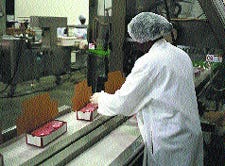Custom-designed cartoning system 'meats' specifications
January 29, 2014
|
Above, the carton is positively ejected onto the carton conveyor. Below, a line worker receives plastic bags of beef patties and fills the newly formed cartons running parallel to the product conveyor. |
|
By the middle of summer, outdoor chefs are just finding their stride when it comes to grilling. Bubba Foods, Elberton, GA, produces a line of frozen beef burgers and installed a new carton-forming system for its Bubba Burger line in 2001. The company needed the new system for its expansion plans. The new system precipitated a collaboration between two machine suppliers: Dorner Manufacturing Corp. and Kliklok-Woodman Co. The new system included a Dorner outfeed 6100 conveyor and a Kliklok-Woodman ECT-625 carton former.
In the past, Kliklok-Woodman has manufactured outfeed conveyors for its carton formers, but they saw an opportunity to contain costs for the customer, PD is told. "This carton former has the flexibility to use a standardized belt conveyor. Although we considered designing and building a custom conveyor, we recognized, that the 6100 could do the job, and at a lower cost to the customer," says Curt Kuhr, manager of marketing services for Kliklok-Woodman.
The carton former's design allows two conveyors to run parallel through its framework; while the 6100 moves newly formed paperboard cartons, supplied by Malnove Inc., the second conveyor carries frozen hamburger patties. Kuhr adds, "The system provides maximum use of floorspace in-between the forming and closing machine." The 6100 conveyor has a one-piece stainless-steel frame and pulleys with a urethane-based sealed-edge belt. The 6100 conveyor option selected is not a washdown model at Bubba Foods, however, the series does offer standard washdown options.
The 6100 conveyor transports the cartons upstream, while the product conveyor carries plastic bags of frozen patties that are manually placed into the cartons. The product conveyor runs parallel with the 6100 conveyor through the carton former, but ends approximately four feet upstream from the machine.
One of the features of the 6100 conveyor is the ability to handle belt tensioning and tracking separately, to improve the speed of reassembly after washdowns. Tensioning is executed by loosening one screw at the end of the conveyor and adjusting the tension with another screw. The tension is applied through a rack-and-pinion system, which applies even tension across the entire belt width.
Belt tracking is achieved via a self-tracking "V"-guided belt. The urethane "V" shaped guide applied to the back of the belt rides in a "V" groove that is formed into the conveyor frame. Gary Wemmert, director of marketing at Dorner, says, "In all of our conveyors, we separate those functions."
Because of stringent FDA requirements, the 6100 conveyor series was engineered without non-accessible areas or "channels" in the structure, where food particles might get trapped. "The whole system has to be cleanable in a food application," says Wemmert. The conveyor's guides, stands and if need be, sensors, are clipped onto the edge of the conveyor structure, rather than screwed into a T-slot channel.
Boxed beef
The other "beef" in this packaging line is the carton former and closer. The carton former is a top-loading system with a rotary, 4-station-turret design. Four mandrels rotate and are equipped with a vacuum carton drawdown device to secure the flat cartons from the magazine. A Nordson 3500 Vista pressurized nozzle system applies hot-melt adhesive to four corners of the hinge-cover tri-seal carton. At Bubba, the machine is averaging 45 cartons/min, but it is capable of 100 cartons/min, PD is told.
After adhesive is applied, the carton is folded and compressed by a reciprocating cavity and then rotated to a strip-off position, where it is positively ejected onto the outfeed conveyor. Bubba Foods packgages its beef patties in two carton sizes, 10 x 4.5 x 3.25 in. and 10 x 9 x 3.25 in.
The carton former is designed to reduce the distance the carton travels between the supply magazine and the forming mandrel. With minimal movement, this results in greater carton control and improved registration, PD is informed. Tom Steele, plant manager at Bubba Foods, says, "The carton former has been a reliable machine."
The newly formed cartons move approximately four feet on the 6100 conveyor, where line workers place plastic bags filled with hamburger patties into cartons. Kuhr adds, "The carton former allows the production line to avoid unnecessary turns and angles in its upstream conveying equipment."
Downstream, a Kliklok-Woodman Genesis Mini carton closer takes the newly filled cartons and applies hot-melt adhesive to three flaps. The front tuck flap of the carton receives hot-melt first, by a Nordson 3400 nozzle-type applicator. The machine folds and compresses the tuck to the carton front panel and then a lugless turner, rotates the carton 90 degrees. After turning, the two cover end flaps receive adhesive and are then compressed to the ends of the body of the carton.
From there, the cartons are loaded into corrugated cases, supplied by International Paper, that are sealed on a 3M case-sealing machine.
Expansion proved to be the catalyst for this collaboration. With the carton former, conveyor and line design proving to be steady and reliable, Bubba hopes to see expansion in sales also.
More information is available:
Conveyors: Dorner Manufacturing, 262/367-7600. Circle No. 227.
Carton former, closer: Kliklok-Woodman, 770/981-5200. Circle No. 228.
Paperboard cartons: Malnove Inc., 904/757-5030. Circle No. 229.
Hot-melt applicator: Nordson Corp., 800/683-2314. Circle No. 230.
Corrugated cases: International Paper, 800/223-1268. Circle No. 231.
Case sealer: 3M Co., 651/733-2045, Circle No. 232.
About the Author(s)
You May Also Like




